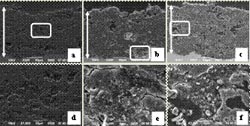Aluminum nitride coatings by atmospheric reactive plasma spray

SEM cross section images of the AlN coatings fabricated with using N2 plasma gas flow rate of: (a) 100, (b) 120, (c) 160 l/min and (d-f) are higher magnifications of the squared parts in (a-c).
For such applications fabrication of thick AlN coating by thermal spray into the chosen material surface considered to be suitable solution. However, it is impossible to fabricate AlN coating directly by conventional thermal spraying due to the AlN thermal decomposition without melting.
Here, Mohammed Shahien and colleagues at Toyohashi University of Technology, Japan report on the realization of cubic AlN coatings on steel substrates by atmospheric reactive plasma spraying of fine Al2O3 feedstock powder in N2/H2 plasma.
The formation process was clarified thus, during spray the particles melted, spheroidized and nitrided in the plasma to form the cubic aluminum oxynitride then cubic-AlN. Furthermore, using smaller particle size enhanced the surface (reaction) area and improved the nitriding conversion.
It was possible to fabricate thick and uniform coatings with high AlN content by spraying fine Al2O3/AlN mixture and the thickness increased from about 150 µm to about 200 µm with increasing the N2 gas flow rate from 100 to 160 l/min.
These results are important for the manufacture of high performance equipment for the materials manufacturing including semiconductors.
Reference
Authors: M. Shahien, M. Yamada, T. Yasui, M. Fukumoto
Title of paper: Aluminum Nitride Coating Fabricated by Reactive Plasma Spraying of Al2O3
Journal: Proceedings of Thermal Spray 2012: Proceedings from the International Thermal Spray Conference and Exposition.May 21–24, 2012, Houston, Texas, USA. Pages: 873-879.
Affiliation: Interface & Surface Fabrication Laboratory, Department of Mechanical Engineering
Media Contact
All latest news from the category: Process Engineering
This special field revolves around processes for modifying material properties (milling, cooling), composition (filtration, distillation) and type (oxidation, hydration).
Valuable information is available on a broad range of technologies including material separation, laser processes, measuring techniques and robot engineering in addition to testing methods and coating and materials analysis processes.
Newest articles

Superradiant atoms could push the boundaries of how precisely time can be measured
Superradiant atoms can help us measure time more precisely than ever. In a new study, researchers from the University of Copenhagen present a new method for measuring the time interval,…

Ion thermoelectric conversion devices for near room temperature
The electrode sheet of the thermoelectric device consists of ionic hydrogel, which is sandwiched between the electrodes to form, and the Prussian blue on the electrode undergoes a redox reaction…

Zap Energy achieves 37-million-degree temperatures in a compact device
New publication reports record electron temperatures for a small-scale, sheared-flow-stabilized Z-pinch fusion device. In the nine decades since humans first produced fusion reactions, only a few fusion technologies have demonstrated…





















